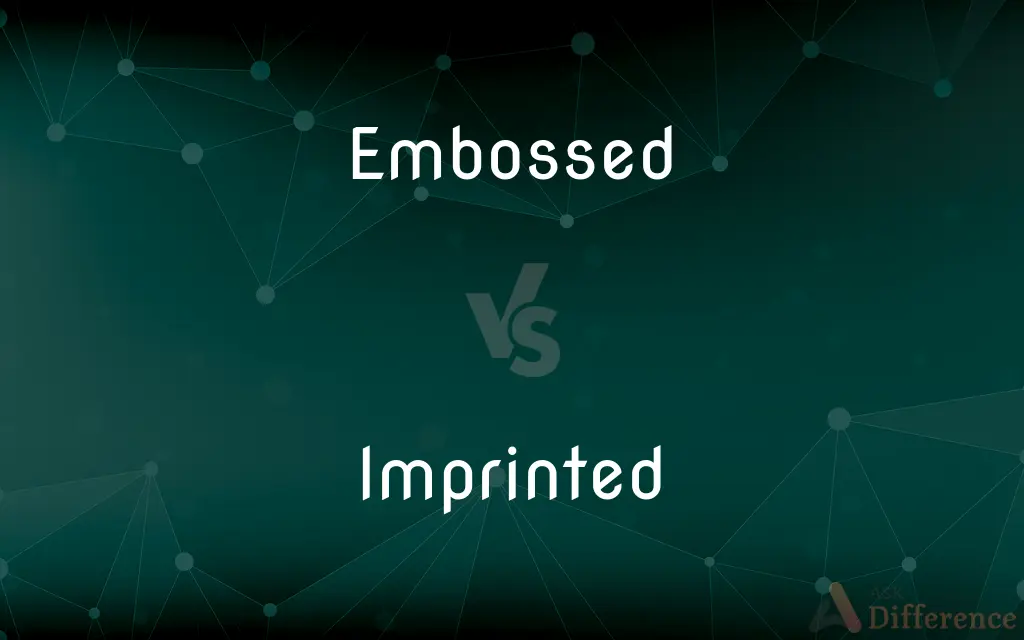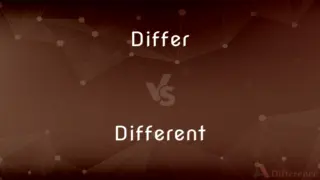Embossed vs. Imprinted — What's the Difference?
By Urooj Arif & Fiza Rafique — Updated on April 4, 2024
Embossed raises the surface, while imprinted presses in.

Difference Between Embossed and Imprinted
Table of Contents
ADVERTISEMENT
Key Differences
Embossing involves creating a raised design or pattern on a surface, making the design perceptible to the touch. This technique is often used in paper products, leather, and metals, where a three-dimensional effect is desired. On the other hand, imprinting refers to pressing a design into a surface, creating a recessed pattern or text. Unlike embossing, imprinted designs are indented and can be used on a wider range of materials, including plastics, metals, and fabrics.
The embossing process often requires a specific set of tools or machines to create the desired raised effect by applying pressure from beneath the material's surface. Conversely, imprinting is achieved by applying pressure to the top of the material, often using stamps or engraved plates that press the design into the material.
Embossed designs are particularly popular in the creation of official documents, business cards, and book covers, where the tactile sensation and visual depth add a sense of luxury and exclusivity. Imprinted designs, however, are commonly found in promotional products, branding, and functional items like controls and buttons, where durability and visibility are key.
The durability of an embossed design can vary depending on the material and the depth of the embossing. Since the design is raised, it may be more susceptible to wear over time, especially on frequently handled items. Imprinted designs, being recessed, are generally more protected from abrasion and wear, making them more durable over time.
In terms of aesthetic appeal, embossing offers a unique tactile experience and visual depth that can enhance the perceived value of an item. Imprinting, while less tactile, can be more versatile, allowing for a wide range of colors and materials to be used, making it suitable for a broader array of applications.
ADVERTISEMENT
Comparison Chart
Surface Effect
Raised design or pattern
Recessed design or pattern
Tools/Machines
Requires tools/machines to apply pressure from beneath
Uses stamps or plates to press design into the material
Popular Uses
Official documents, business cards, luxury items
Promotional products, branding, functional items
Durability
Can vary; designs may wear over time
Generally more durable due to recessed design
Aesthetic Appeal
Adds tactile sensation and visual depth
Versatile, suitable for a broad range of applications
Compare with Definitions
Embossed
A technique creating a raised design on a surface.
The wedding invitation featured embossed gold lettering.
Imprinted
A method of creating a recessed design by pressing into a surface.
The promotional pen was imprinted with the brand's name.
Embossed
Associated with exclusivity and elegance.
Embossed leather wallets are seen as high-end accessories.
Imprinted
Widely used for branding and promotional items.
Corporate gifts often feature imprinted logos.
Embossed
Used to enhance visual and tactile appeal.
The luxury notebook's cover was embossed with the company logo.
Imprinted
Suitable for a variety of materials.
The machine's controls were imprinted with symbols for easy identification.
Embossed
Applies to various materials but common in paper products.
The certificate had an embossed seal.
Imprinted
Ensures durability of the design.
The work gloves had imprinted grips for long-lasting use.
Embossed
Requires specialized equipment for the process.
Manufacturers use embossing machines to create textured patterns.
Imprinted
Can involve various colors and techniques.
The T-shirt featured a brightly imprinted graphic on the front.
Embossed
To mold or carve in relief
Emboss a design on a coin.
Imprinted
To produce (a mark or pattern) on a surface by pressure.
Embossed
To decorate with or as if with a raised design
Emboss leather.
Imprinted
To produce a mark on (a surface) by pressure.
Embossed
To adorn; decorate.
Imprinted
To impart a strong or vivid impression of
"We imprint our own ideas onto acts" (Ellen Goodman).
Embossed
To cover with many protuberances; stud
“The whole buoy was embossed with barnacles” (Herman Melville).
Imprinted
To fix firmly, as in the mind
He tried to imprint the telephone number in his memory.
Embossed
Simple past tense and past participle of emboss
Imprinted
To cause (a very young animal) to recognize and be attracted to another animal or to an object identified as the parent. Often used with on.
Embossed
With raised letters or images on the surface.
Imprinted
To modify (a gene) chemically, as by DNA methylation, affecting the gene's expression in offspring.
Embossed
Formed or covered with bosses or raised figures.
Imprinted
To become imprinted on another animal or on an object identified as the parent. Used of newborn or very young animals. Often used with on
Lab animals that imprint on researchers.
Embossed
Having a part projecting like the boss of a shield.
Imprinted
A mark or pattern produced by imprinting; an impression.
Embossed
Swollen; protuberant.
Imprinted
A distinguishing influence or effect
Spanish architecture that shows the imprint of Islamic rule.
Embossed
Embellished with a raised pattern created by pressure or embroidery;
Brocaded silk
An embossed satin
Embossed leather
Raised needlework
Raised metalwork
Imprinted
A chemical modification of a gene affecting the gene's expression in offspring.
Imprinted
A publisher's name, often with the date, address, and edition, printed at the bottom of a title page of a publication.
Imprinted
A publishing business with a unique name, usually owned by a larger publishing firm
Started a paperback imprint for young-adult novels.
Imprinted
Simple past tense and past participle of imprint
Imprinted
Stamped or impressed.
Imprinted
(genetics) Produced by or exhibiting imprinting; showing distinction by its origin from the paternal or maternal genome.
Common Curiosities
Can embossed and imprinted designs be used together?
Yes, combining both techniques can create unique, multi-dimensional effects on an item.
Is imprinting more cost-effective than embossing?
Generally, imprinting can be more cost-effective, especially for larger quantities, due to its simpler process.
Which technique offers more durability?
Imprinted designs tend to be more durable, especially on items that are handled frequently.
Which technique is better for paper products, embossing or imprinting?
Embossing is often preferred for paper products due to its luxurious and tactile appeal.
How does the choice between embossing and imprinting affect the design process?
The choice affects the design's complexity, the types of materials used, and the overall aesthetic and functional goals of the project.
Can any printer do embossing?
No, embossing requires specialized equipment and cannot be achieved with standard printers.
Can color be added to embossed designs?
Yes, color can be added to embossed designs, but it’s more commonly associated with imprinting.
Is embossing environmentally friendly?
The environmental impact depends on the materials and processes used; however, both techniques can be adapted to more eco-friendly practices.
Are there any limitations to the size of the design for either technique?
Yes, both techniques have limitations based on the equipment used and the material's nature.
Are there materials that are more suited to one technique over the other?
Yes, softer materials like paper and leather are ideal for embossing, while harder materials like metal and plastic are suitable for imprinting.
What are the cost drivers for embossing and imprinting?
Factors include the complexity of the design, materials used, and the quantity produced.
Is specialized training required to perform embossing or imprinting?
Yes, specialized training or expertise is often required to achieve high-quality results in both techniques.
Can embossing be done on metal?
Yes, embossing can be done on metal, especially on softer metals like aluminum.
How long do embossed and imprinted designs last?
The longevity of embossed and imprinted designs varies with the material, usage, and quality of the process.
How do I choose between embossing and imprinting for my project?
Consider the material, desired aesthetic, durability needs, and budget when choosing between these techniques.
Share Your Discovery

Previous Comparison
Differ vs. Different
Next Comparison
Mar vs. MirAuthor Spotlight
Written by
Urooj ArifUrooj is a skilled content writer at Ask Difference, known for her exceptional ability to simplify complex topics into engaging and informative content. With a passion for research and a flair for clear, concise writing, she consistently delivers articles that resonate with our diverse audience.
Co-written by
Fiza RafiqueFiza Rafique is a skilled content writer at AskDifference.com, where she meticulously refines and enhances written pieces. Drawing from her vast editorial expertise, Fiza ensures clarity, accuracy, and precision in every article. Passionate about language, she continually seeks to elevate the quality of content for readers worldwide.















































